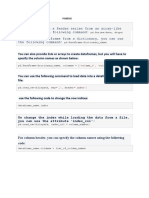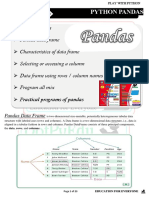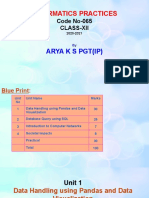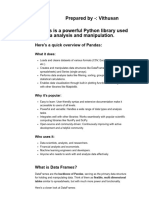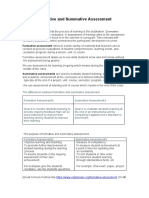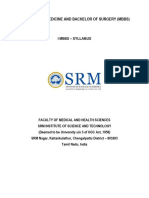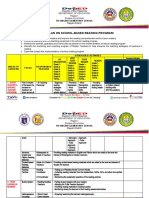8/8/25, 9:00 p.m.
about:blank
Working with Data in Python Cheat Sheet
Reading and writing files
Package/Method Description Syntax and Code Example
Syntax: r (reading) w (writing) a (appending) + (updating: read/write) b (binary, otherwise text)
Examples: with open("data.txt", "r") as file: content = file.read() print(content) with open("output.txt", "w") as f
Different
modes to
File opening
open files
modes
for specific
operations.
Syntax:
file.readlines() # reads all lines as a list
readline() # reads the next line as a string
file.read() # reads the entire file content as a string
Different
methods to
File reading read file
methods content in Example:
various
ways. with open("data.txt", "r") as file:
lines = file.readlines()
next_line = file.readline()
content = file.read()
Syntax:
file.write(content) # writes a string to the file
file.writelines(lines) # writes a list of strings to the file
Different
write
File writing methods to
methods write Example:
content to a
file. lines = ["Hello\n", "World\n"]
with open("output.txt", "w") as file:
file.writelines(lines)
Iterating over Iterates Syntax:
lines through
for line in file: # Code to process each line
each line in
the file
about:blank 1/9
�8/8/25, 9:00 p.m. about:blank
using a
`loop`.
Example:
with open("data.txt", "r") as file:
for line in file: print(line)
Syntax:
file = open(filename, mode) # Code that uses the file
file.close()
Opens a
file,
performs
operations,
Open() and and
close() explicitly Example:
closes the
file using file = open("data.txt", "r")
content = file.read()
the close() file.close()
method.
Syntax:
with open(filename, mode) as file: # Code that uses the file
Opens a file
using a with
block,
with open() ensuring Example:
automatic
file closure with open("data.txt", "r") as file:
after usage. content = file.read()
Pandas
Package/Method Description Syntax and Code Example
Reads data from a `.CSV` file and creates a Syntax: dataframe_name = pd.read_csv("filename.csv") Example: df =
.read_csv()
DataFrame. pd.read_csv("data.csv")
about:blank 2/9
�8/8/25, 9:00 p.m. about:blank
Syntax:
dataframe_name = pd.read_excel("filename.xlsx")
Reads data from an Excel file and creates a
.read_excel()
DataFrame. Example:
df = pd.read_excel("data.xlsx")
Syntax:
dataframe_name.to_csv("output.csv", index=False)
.to_csv() Writes DataFrame to a CSV file.
Example:
df.to_csv("output.csv", index=False)
Syntax:
dataframe_name["column_name"] # Accesses single column
dataframe_name[["column1", "column2"]] # Accesses multiple columns
Access Columns Accesses a specific column using [] in the DataFrame.
Example:
df["age"]
df[["name", "age"]]
describe() Generates statistics summary of numeric columns in Syntax:
the DataFrame.
dataframe_name.describe()
about:blank 3/9
�8/8/25, 9:00 p.m. about:blank
Example:
df.describe()
Syntax:
dataframe_name.drop(["column1", "column2"], axis=1, inplace=True)
dataframe_name.drop(index=[row1, row2], axis=0, inplace=True)
Removes specified rows or columns from the
drop() DataFrame. axis=1 indicates columns. axis=0
indicates rows. Example:
df.drop(["age", "salary"], axis=1, inplace=True) # Will drop columns
df.drop(index=[5, 10], axis=0, inplace=True) # Will drop rows
Syntax:
dataframe_name.dropna(axis=0, inplace=True)
Removes rows with missing NaN values from the
dropna()
DataFrame. axis=0 indicates rows. Example:
df.dropna(axis=0, inplace=True)
duplicated() Duplicate or repetitive values or records within a data Syntax:
set.
dataframe_name.duplicated()
about:blank 4/9
�8/8/25, 9:00 p.m. about:blank
Example:
duplicate_rows = df[df.duplicated()]
Syntax:
filtered_df = dataframe_name[(Conditional_statements)]
Creates a new DataFrame with rows that meet
Filter Rows
specified conditions. Example:
filtered_df = df[(df["age"] > 30) & (df["salary"] < 50000)
Syntax:
grouped = dataframe_name.groupby(by, axis=0, level=None, as_index=True,
sort=True, group_keys=True, squeeze=False, observed=False, dropna=True)
Splits a DataFrame into groups based on specified
groupby() criteria, enabling subsequent aggregation,
transformation, or analysis within each group. Example:
grouped = df.groupby(["category", "region"]).agg({"sales": "sum"})
head() Displays the first n rows of the DataFrame. Syntax:
dataframe_name.head(n)
about:blank 5/9
�8/8/25, 9:00 p.m. about:blank
Example:
df.head(5)
Syntax:
import pandas as pd
Import pandas Imports the Pandas library with the alias pd.
Example:
import pandas as pd
Syntax:
dataframe_name.info()
Provides information about the DataFrame, including
info()
data types and memory usage. Example:
df.info()
merge() Merges two DataFrames based on multiple common Syntax:
columns.
merged_df = pd.merge(df1, df2, on=["column1", "column2"])
Example:
merged_df = pd.merge(sales, products, on=["product_id", "category_id"])
about:blank 6/9
�8/8/25, 9:00 p.m. about:blank
Syntax:
print(df) # or just type df
print DataFrame Displays the content of the DataFrame.
Example:
print(df)
df
Syntax:
dataframe_name["column_name"].replace(old_value, new_value, inplace=True)
replace() Replaces specific values in a column with new values.
Example:
df["status"].replace("In Progress", "Active", inplace=True)
tail() Displays the last n rows of the DataFrame. Syntax:
dataframe_name.tail(n)
Example:
df.tail(5)
about:blank 7/9
�8/8/25, 9:00 p.m. about:blank
Numpy
Package/Method Description Syntax and Code Example
Syntax:
import numpy as np
Importing NumPy Imports the NumPy library.
Example:
import numpy as np
Syntax:
array_1d = np.array([list1 values]) # 1D Array
array_2d = np.array([[list1 values], [list2 values]]) # 2D Array
np.array() Creates a one or multi-dimensional array,
Example:
array_1d = np.array([1, 2, 3]) # 1D Array
array_2d = np.array([[1, 2], [3, 4]]) # 2D Array
Example:
np.mean(array)
np.sum(array)
np.min(array
np.max(array)
- Calculates the mean of array elements np.dot(array_1, array_2)
- Calculates the sum of array elements
Numpy Array Attributes - Finds the minimum value in the array
- Finds the maximum value in the array
- Computes dot product of two arrays
about:blank 8/9
�8/8/25, 9:00 p.m. about:blank
© IBM Corporation. All rights reserved.
about:blank 9/9




